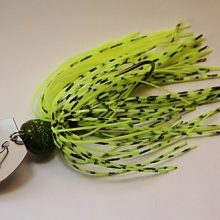This article may contain affiliate links. If you make a purchase after clicking on a link we may earn a small commission at no extra cost to you. As an Amazon Associate, I earn from qualifying purchases.
Chatterbait Setup

Chatterbaits are absolutely dynamite for working over thick grass cover.
They are also referred to a bladed jigs, so you will often see the two terms used interchangeably.
A good chatterbait setup should have enough backbone through the rod blank to enable you to work your lure through thick cover and to play a bass out of thick weeds.
You will also need a reel that has a fairly high gearing to help rip them quickly through the water should you need to.
You can use the following combo as a rough guide for a decent bladed jig setup:
- Rod – Baitcasting rod, medium/heavy power, fast action roughly 7 feet in length
- Reel- Baitcaster reel with a high gear ratio for quick retrieve
- Line – Braid for thick weed work or fluorocarbon for open water work
The above setup for chatterbaits can be used in just about any scenario. Although if you are using large chatterbaits on open water you may want a more moderate tip action to help delay the hook-set ever so slightly.
But I prefer just to allow a slight pause to allow the bass really get it’s mouth around the lure especially if using a really large trailer like a crawdad or swimbait.
Chatterbait Setup
1. Rod
Pretty much any rod that you can use for a spinnerbait you can use for a bladed jig or chatterbait.
Look for a rod of between 6’6″ and 7’3″ in length. Personally I use a seven footer as a great compromise.
When choosing a chatterbait rod you need to look at the type of water you will be fishing in regularly.
If that water is filled with heavy weed beds then you need a decent powered rod that is strong enough to haul a bass out of thick cover.
Action wise look for a fast action for almost all applications unless you are using really big lure in open water.
In this scenario a more moderate action will be better as it will delay the hook-set and give the bass an extra few milliseconds to fully engage with your lure.
2. Reel
Look to use a baitcaster reel that high gear ratio for quick line retrieve. A gear ratio of at least 6.3:1 should be sufficient.
Burning a chatterbait over the tops of grass is a very effective strategy.
When burning line in quickly it really makes a bladed jig cause a lot of disturbance just below the surface and in the right conditions a big bass will smash the lures as a reaction strike.
In order to quickly burn you need a decent gearing on your reel.
A baitcaster is the go to setup for chatterbaits as it makes casting all day much less of a chore than when using a spinning reel for bass.
3. Line
The best line for chatterbaits will usually boil down to a choice of using either braid or fluorocarbon and this is due to the low stretch properties of both of these types of line.
Braid is great in heavy weed cover as it can slice through thick weeds much more easily due to it’s smaller diameter.
I still like to use a fluorocarbon leader though of between 4 and 6 feet in length.
Look for roughly 30 lb braid in really heavy cover and 12 lb fluorocarbon line in open water.
However, in open or clear water it is very visible and this is where fluorocarbon line will excel.
Saying that some anglers will use mono, the usually reason for this is that it floats much better than the other two and if you are working in the top foot or so of water then it might make sense.
